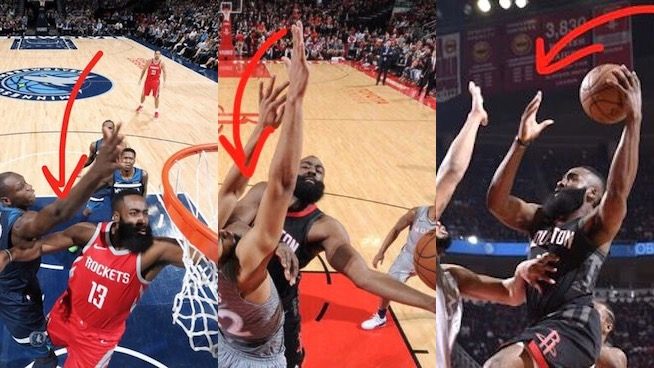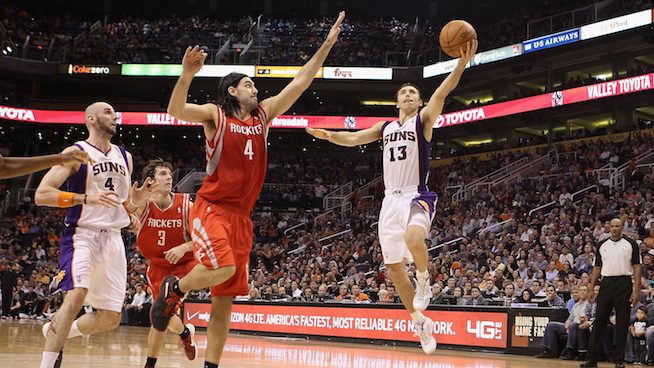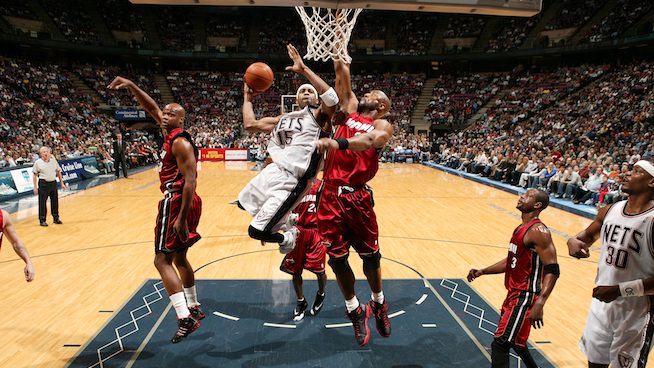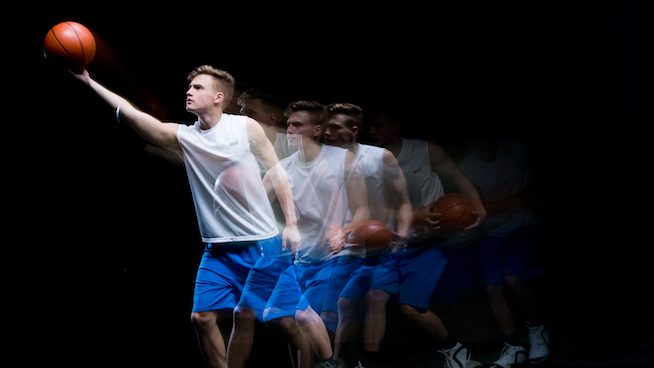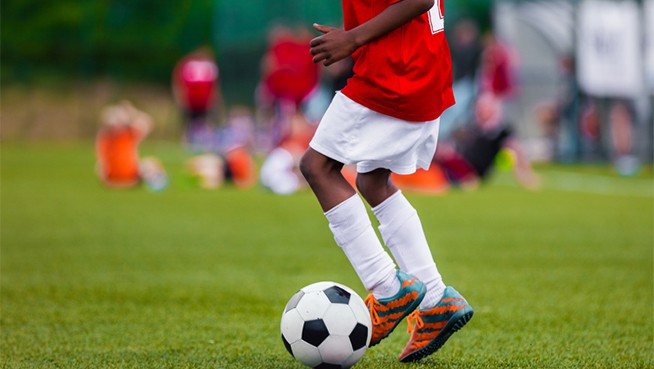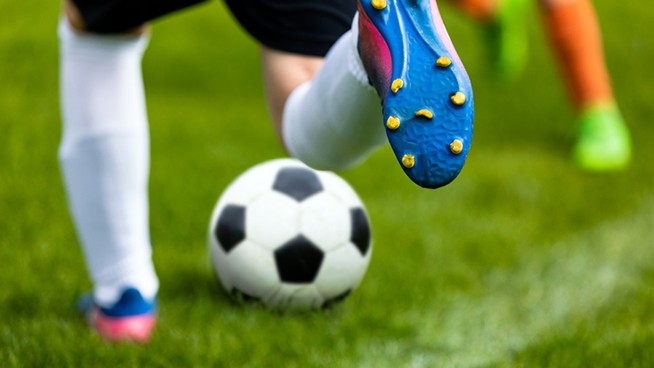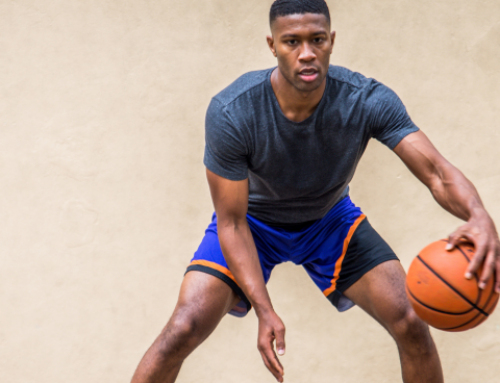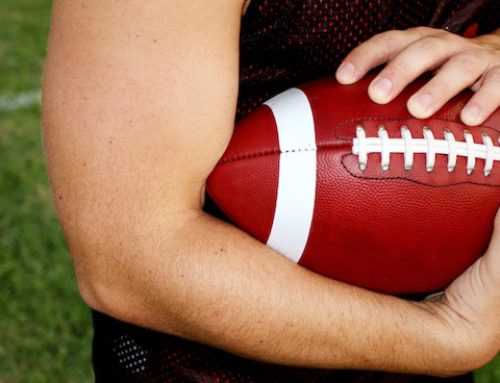5 Steps to Becoming a Better Finisher Around The Rim
Finishing around the basket.
Consistently converting on your close-range opportunities can help you fill up the stat sheet in a hurry and open things up for your teammates.
There are two quick ways you can improve your finishing ability:
- Get better at finishing through contact.
- Get better at finishing over and around bigger defenders.
If you can do both of those things, there’s really no limit to just how good of a finisher you can become. Guys like Kyrie Irving and James Harden are able to finish in almost any situation thanks to their strong, versatile finishing ability. To help you get better around the basket, here are five things to work on that can make you a better finisher.
1. Learn to Love the Glass From Every Angle
Kyrie uses the glass better than anyone.
How is he able to create such incredible English on the ball and bank it in from seemingly impossible angles? Because he’s practiced it thousands of times.
In the above video for USA basketball, Kyrie explains how he uses the “Mikan Drill” to develop his skills. Named after legendary player George Mikan, the basic drill simply requires you to make layups with both hands on both sides of the basket. From there, Kyrie varies the drill by toying with factors like his distance from the rim, where he aims on the backboard, and what legs he finishes off of. This article goes into further detail on Irving’s use of the Mikan Drill. In this video from Nike, Kyrie further discusses how he gained such an intimate knowledge of the glass:
These variations will force you to experiment with the amount and direction of spin you put on the ball. This is something that will take repetition to master as each different spot and angle will require a unique spin, but eventually you’ll be able to make the calculations in your head and know intrinsically where and how to put the ball off the backboard. The more you rep it, the better you’ll become. If you only practice basic layups with basic backboard placement, that’s all you can expect to make during games.
2. Work on Protecting the Ball
One important thing I try to teach players from an early age is learning to think about where the defender will be in relation to the ball when you go in for your layup. Are they ogoing to be on the right side of your body? Then think about taking the ball out to your left. Are they going to be closing in fast on your left? Then think about taking the ball to your right. Are they going to be dead ahead of you? Then think about taking the ball low before going for the glass.
Ball protection is all about getting comfortable with extending your arms in a variety of directions—high, to the left, to the right, toward your knees. By extending your arms in the right direction, you maximize the amount of separation between the ball and the defender.
Ball protection also means how good you are going at using the off-hand when you’re jumping for your finish. You can’t extend your off-hand directly into a defender’s body like a running back throwing a stiff-arm—that’s a foul. However, you can use your hand and forearm to shield the ball.
Take a closer look at the three pictures of James Harden above. What do you see in common? He’s using his off-hand to protect the ball without fouling while keeping the ball extended away from the defender. Think about the personal space you want when taking a subway during rush hour. Just like you want personal space then, you want personal space in the paint. The defender doesn’t want to give it to you, so it’s on you to create it.
The more you practice protecting the ball with both your layup hand and your off-hand, the more natural it will be during live competition.
3. Learn Variety in Your Footwork
Imagine the versatility you’d have at your disposal if you could jump off any foot at any time in any direction when handling the ball and driving to the hoop.
The more variety you have in your footwork, the tougher you’ll be to defend. Steve Nash and Jimmer Fredette are two great players with excellent footwork variety.
Much of Nash’s great footwork comes from his strong soccer background. Developing variety in your footwork is as simple as mixing up your training. Instead of practicing the same close-range move over and over, throw in jab steps, Eurosteps, fadeaways, etc. Practicing finishing against a bigger, stronger opponent which naturally forces you to develop a wide array of footwork.
The more variety you have in your footwork, the more creative you can be on the court. And the more creative you are, the tougher you’ll be to defend.
4. Develop Good Functional Core Strength
If you want to be a great finisher around the rim, you need to develop good functional core strength.
That means developing a core that’s capable of resisting force so you can absorb contact and keep your focus on converting the basket. If you fold like an accordion any time you get touched, you’re not going to be a very good finisher.
To do develop this type of core strength, you need to focus on what are known as “anti-” movements. These type of movements train your core to dynamically prevent extension, rotation and lateral flexion. Look at how Vince Carter’s core is helping him fight through contact in the above picture as he attacks the rim. A strong, stable core will both help you stabilize yourself in mid-air and also transfer energy from your lower body to your upper body.
One of my favorite core exercises is a simple forearm Plank where the athlete both places and takes away a small ball off their lower back throughout the duration of the rep. The addition of the ball really forces you to focus on resisting rotation through your hips and extension through your lower back. See a video here.
5. Learn Patience in the Paint
Patience is a virtue.
When you get close to the hoop, it’s natural for young players to rush and feel like they need to quickly get a shot up. But learning to use techniques like jump-stops and pump fakes can make you an even deadlier finisher and help you live on the free-throw line. Sure, blowing straight by a defender and taking it right to the rack is nice. But if you can integrate more patient attacks into your game, your speed will be even more effective.
If you improve in any one of these five areas, you can become a better finisher. If you improve in all five of them and practice them consistently, you should see big increases in your finishing ability. If you spend 30 minutes each day working on your finishing skills, you’ll be on your way to being an unstoppable finisher.
Photo Credit: Nathaniel S. Butler/Getty Images, Christian Petersen/Getty Images, 4×6/iStock
READ MORE:
RECOMMENDED FOR YOU
5 Steps to Becoming a Better Finisher Around The Rim
Finishing around the basket.
Consistently converting on your close-range opportunities can help you fill up the stat sheet in a hurry and open things up for your teammates.
There are two quick ways you can improve your finishing ability:
- Get better at finishing through contact.
- Get better at finishing over and around bigger defenders.
If you can do both of those things, there’s really no limit to just how good of a finisher you can become. Guys like Kyrie Irving and James Harden are able to finish in almost any situation thanks to their strong, versatile finishing ability. To help you get better around the basket, here are five things to work on that can make you a better finisher.
1. Learn to Love the Glass From Every Angle
Kyrie uses the glass better than anyone.
How is he able to create such incredible English on the ball and bank it in from seemingly impossible angles? Because he’s practiced it thousands of times.
In the above video for USA basketball, Kyrie explains how he uses the “Mikan Drill” to develop his skills. Named after legendary player George Mikan, the basic drill simply requires you to make layups with both hands on both sides of the basket. From there, Kyrie varies the drill by toying with factors like his distance from the rim, where he aims on the backboard, and what legs he finishes off of. This article goes into further detail on Irving’s use of the Mikan Drill. In this video from Nike, Kyrie further discusses how he gained such an intimate knowledge of the glass:
These variations will force you to experiment with the amount and direction of spin you put on the ball. This is something that will take repetition to master as each different spot and angle will require a unique spin, but eventually you’ll be able to make the calculations in your head and know intrinsically where and how to put the ball off the backboard. The more you rep it, the better you’ll become. If you only practice basic layups with basic backboard placement, that’s all you can expect to make during games.
2. Work on Protecting the Ball
One important thing I try to teach players from an early age is learning to think about where the defender will be in relation to the ball when you go in for your layup. Are they ogoing to be on the right side of your body? Then think about taking the ball out to your left. Are they going to be closing in fast on your left? Then think about taking the ball to your right. Are they going to be dead ahead of you? Then think about taking the ball low before going for the glass.
Ball protection is all about getting comfortable with extending your arms in a variety of directions—high, to the left, to the right, toward your knees. By extending your arms in the right direction, you maximize the amount of separation between the ball and the defender.
Ball protection also means how good you are going at using the off-hand when you’re jumping for your finish. You can’t extend your off-hand directly into a defender’s body like a running back throwing a stiff-arm—that’s a foul. However, you can use your hand and forearm to shield the ball.
Take a closer look at the three pictures of James Harden above. What do you see in common? He’s using his off-hand to protect the ball without fouling while keeping the ball extended away from the defender. Think about the personal space you want when taking a subway during rush hour. Just like you want personal space then, you want personal space in the paint. The defender doesn’t want to give it to you, so it’s on you to create it.
The more you practice protecting the ball with both your layup hand and your off-hand, the more natural it will be during live competition.
3. Learn Variety in Your Footwork
Imagine the versatility you’d have at your disposal if you could jump off any foot at any time in any direction when handling the ball and driving to the hoop.
The more variety you have in your footwork, the tougher you’ll be to defend. Steve Nash and Jimmer Fredette are two great players with excellent footwork variety.
Much of Nash’s great footwork comes from his strong soccer background. Developing variety in your footwork is as simple as mixing up your training. Instead of practicing the same close-range move over and over, throw in jab steps, Eurosteps, fadeaways, etc. Practicing finishing against a bigger, stronger opponent which naturally forces you to develop a wide array of footwork.
The more variety you have in your footwork, the more creative you can be on the court. And the more creative you are, the tougher you’ll be to defend.
4. Develop Good Functional Core Strength
If you want to be a great finisher around the rim, you need to develop good functional core strength.
That means developing a core that’s capable of resisting force so you can absorb contact and keep your focus on converting the basket. If you fold like an accordion any time you get touched, you’re not going to be a very good finisher.
To do develop this type of core strength, you need to focus on what are known as “anti-” movements. These type of movements train your core to dynamically prevent extension, rotation and lateral flexion. Look at how Vince Carter’s core is helping him fight through contact in the above picture as he attacks the rim. A strong, stable core will both help you stabilize yourself in mid-air and also transfer energy from your lower body to your upper body.
One of my favorite core exercises is a simple forearm Plank where the athlete both places and takes away a small ball off their lower back throughout the duration of the rep. The addition of the ball really forces you to focus on resisting rotation through your hips and extension through your lower back. See a video here.
5. Learn Patience in the Paint
Patience is a virtue.
When you get close to the hoop, it’s natural for young players to rush and feel like they need to quickly get a shot up. But learning to use techniques like jump-stops and pump fakes can make you an even deadlier finisher and help you live on the free-throw line. Sure, blowing straight by a defender and taking it right to the rack is nice. But if you can integrate more patient attacks into your game, your speed will be even more effective.
If you improve in any one of these five areas, you can become a better finisher. If you improve in all five of them and practice them consistently, you should see big increases in your finishing ability. If you spend 30 minutes each day working on your finishing skills, you’ll be on your way to being an unstoppable finisher.
Photo Credit: Nathaniel S. Butler/Getty Images, Christian Petersen/Getty Images, 4×6/iStock
READ MORE:

